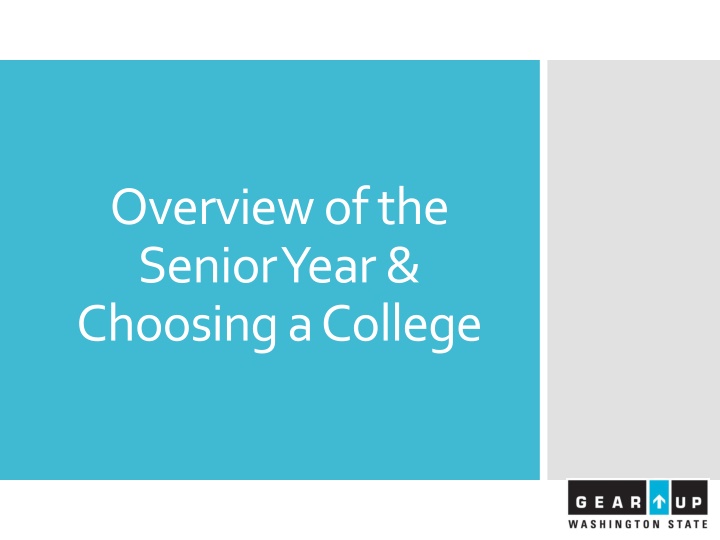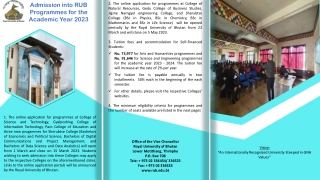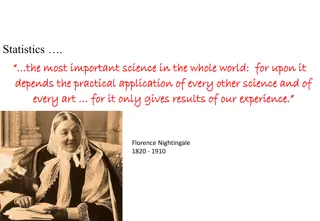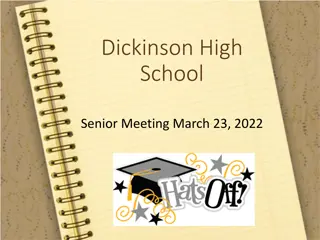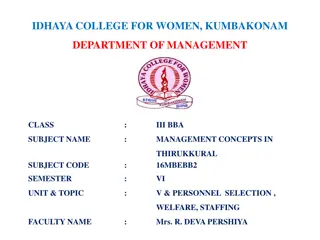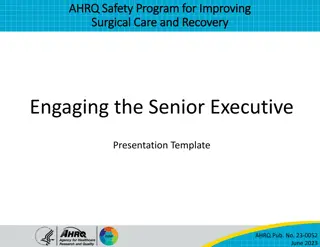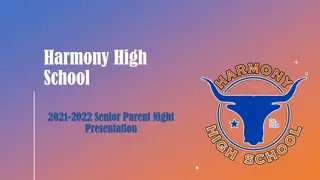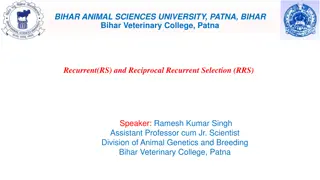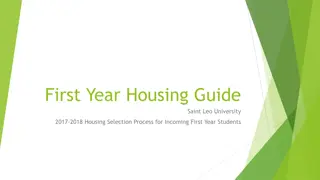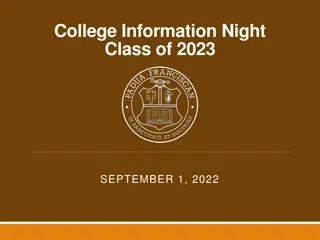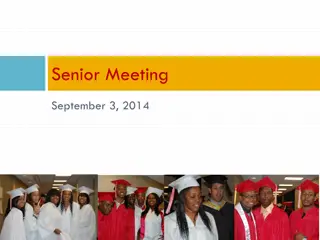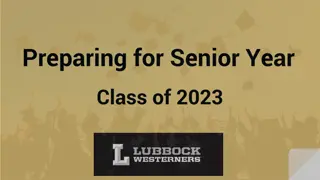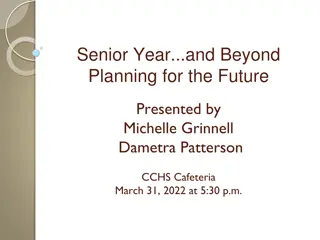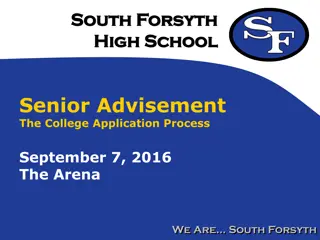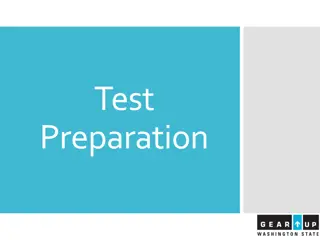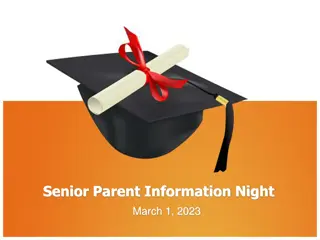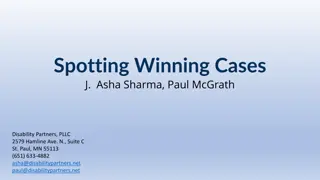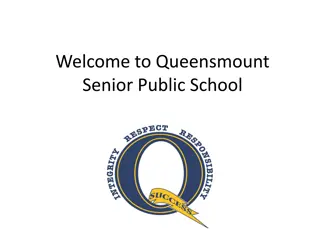Senior Year and College Selection Guide
Navigate the senior year with guidance on college options, application preparation, deadlines, financial aid, scholarships, and decision-making process. Understand the difference between two-year and four-year colleges, and learn how to find the right fit for you. Explore aspects like personal values, location, student life, college type, and program of study to make an informed choice. Get tips on creating application calendars, seeking recommendations, and identifying scholarships.
Download Presentation

Please find below an Image/Link to download the presentation.
The content on the website is provided AS IS for your information and personal use only. It may not be sold, licensed, or shared on other websites without obtaining consent from the author.If you encounter any issues during the download, it is possible that the publisher has removed the file from their server.
You are allowed to download the files provided on this website for personal or commercial use, subject to the condition that they are used lawfully. All files are the property of their respective owners.
The content on the website is provided AS IS for your information and personal use only. It may not be sold, licensed, or shared on other websites without obtaining consent from the author.
E N D
Presentation Transcript
Overview of the Senior Year & Choosing a College
Introductions Our GEAR UP Team includes:
oWhen we say college, we mean any type of education or training after high school. We also use the terms postsecondary education and postsecondary training . oThere are many options for students after high school, including apprenticeships, military, on-the- job training programs, community college certificates, two-year degrees, and four-year degrees. oThe term college includes all of these things. What do we mean when we say college?
College application prep SAT/ACT tests Early admissions deadlines Scholarship applications Submit a FAFSA/WASFA Fall College applications due Scholarship applications Winter Overview: The Whole Picture Award/acceptance letters Choosing a college Scholarship applications Spring Two-year financial aid awards Scholarship awards & applications College orientation Summer
Four-year College Two-year College Personal information Transcript Financial Aid Information Placement test Program-specific prerequisites Personal Information Transcript Letter of Recommendation Standardized Test Scores Financial Aid Information Resume of Activities Essay and Short Answer Questions College Applications: Two-years vs. Four- years
Figure out which colleges are the right fit and make reach/target/safety list. Create a calendar of application and financial aid deadlines. Identify references for letters of recommendation. Begin scholarship searches. September Tasks
Size Personal Values Location Finding the Right Fit Student Life Type of College Student Services Program of Study
Reach Target Safety Academically challenging-- student may not quite fit the college s academic profile. Selective admissions. Potentially high cost of attendance. Student is likely to be admitted based on their academic profile. Student would be happy attending that college. Would not be financially overwhelming to attend. Student is almost certain to be admitted. Student would be happy and get a good education there. Affordable with reasonable effort. September: Reach, Target, Safety
Meet regular decision deadlines. Attend financial aid workshops. File the FAFSA or the WASFA. October Tasks
Register for SAT/ACT Talk with English teacher or counselor about essays. Draft Request official high school transcripts. admission and scholarship essays. SAT collegeboard.org ACT actstudent.org October Tasks
Combines the American College Application Campaign and College Goal Washington (FAFSA/WASFA completion) Links the college application and financial aid processes. October: The 12th Year Campaign
October November Free, on-site program that helps students and families complete the Free Application for Federal Student Aid (FAFSA) or Washington Application for State Financial Aid (WASFA). College Goal Washington
Attend a College Fair. Finish application essays. Visit college campuses. November Tasks
January and February Overview Complete college applications Complete scholarship applications. Keep your grades up!
Decide where to go and send required materials to college. Review acceptance letters and financial aid awards. March & April Overview Scholarships keep applying!
May 1: National Candidates Reply Date Thank you notes May & June Overview Final transcript College deadlines Graduation!
ACT: http://www.act.org/content/dam/act/unsecured/do cuments/FeeWaiver.pdf SAT (The College Board): http://professionals.collegeboard.com/guidance/ap plications/fee-waivers Test & Application Fee Waivers National Association for College Admission Counseling: www.nacacnet.org/studentinfo/feewaiver/pages/de fault.aspx College or University-Specific: See Office of Admissions websites at each college. College Bound students: OSPI
Students should go to the college that is the best fit for them. If it happens to be prestigious, that's fine. Best fit has to do with how students feel when they are on campus. Is the school a good fit for how your child learns? How the professors teach? College Fit Students who go to schools that aren't a good fit are likely to be unhappy, regardless of the school's prestige and more likely to drop out.
Academic Fit Am I clear about what I want to study? Does this school have a program in that subject area? Am I undecided about what I want to study and need a broad range of options? What is my ideal learning environment (small and intimate or in large lecture halls)? Am I prepared for the academic challenge at this college? If I decide to change my major, are there other academic programs that interest me? Understanding Fit
Social Fit Do most students live on campus or commute to school? What is the campus culture? What activities are most popular on campus (athletics, Greek life, community service)? What is the town/city like around the campus? How do key campus demographics fit into my priorities? Understanding Fit
Financial Fit What are the criteria for merit- based scholarships? What is the total cost of attendance? What percentage of students receive need-based financial aid? Can I afford to attend this college with manageable loan debt? Understanding Fit
Whats Important Available academic programs & majors in the field of interest Available support services Campus atmosphere Distance from home Diversity of students Extracurricular activities Financial aid offered Graduation & employment rate Housing options Location Size of school & class size What s Not Best friend is going Boyfriend or girlfriend is going Good sports teams (for non- athletes) It s closest to home School colors The sticker price of that program Finding the Right Fit: Choosing a College
Fit research includes examining the following characteristics of a college: Academic Social Financial Do Fit Research
Basic Research Research which is completed by accessing general and easy-to-find information on a college s website. Fit Research Research that is completed by thoroughly reviewing a college s website from top to bottom and by consulting reliable secondary sources. The information found at the fit level is typically more specific, informative and meaningful than the information found at the surface level. Fit Research: Levels of Research
Basic Research Mission of the school Majors offered Academic programs (e.g., study abroad, research opportunities, co-op programs) School/program rankings Fit Research: Academic Fit Fit Research Courses offered/profiles of key faculty Class size Academic support (e.g., writing center, tutoring) Retention and graduation rates Career services and job placements
Basic Research Location Diversity of student body Clubs, organizations, events and activities Fit Research Gender breakdown Socioeconomic breakdown Geographic breakdown Housing options College culture Presence of Greek life Personal support services (multicultural center, counseling, healthcare, etc.) Particular religious affiliation Fit Research: Social Fit
Basic Research Tuition and room/board costs Institutional scholarships Fit Research Additional costs and fees (transportation, books, lab fees, etc.) Financial aid counseling Percentage of students receiving need-based aid Work-study options Average loan debt upon graduation Fit Research: Financial Fit
The Power to Select Completing fit research will provide you with the information you need to make an appropriate college selection. Benefits and Impact of Fit Research The Power to Impress Completing fit research will provide you with a depth of knowledge about a school to impress admissions officers in essays and interviews.
College Scorecard : Enter the name of a college to find out about its Affordability and value. Make informed decisions about college by searching by degree/major, size of college, occupation, zip code and more. Generate a college scorecard. www.collegecost.ed.gov/scorecard College Greenlight: Connects first generation and under- represented students to caring colleges, generous scholarships and life-changing counselors and mentors. Helps you find the perfect school and sends you reminders about application deadlines and scholarships matches.www.collegegreenlight.com Unigo: Advice and reviews from current college students, including videos and photos. College counselors and other experts offer information and advice. Are they into the same things as you? Your college should be as unique as you are. Find a match!www.unigo.com Big Future Finding Your College Fit: Gives students free, comprehensive college planning resources. Students can make college plans, compare schools, access scholarships, and much more. https://bigfuture.collegeboard.org/find- colleges/how-find-your-college-fit Resources
Contact information: [insert counselor/advisor/mentor name] Phone: (xxx) xxx-xxxx E-mail: xxxx@xxxx.xxx Thanks for coming
Topic Next Family Night Date
